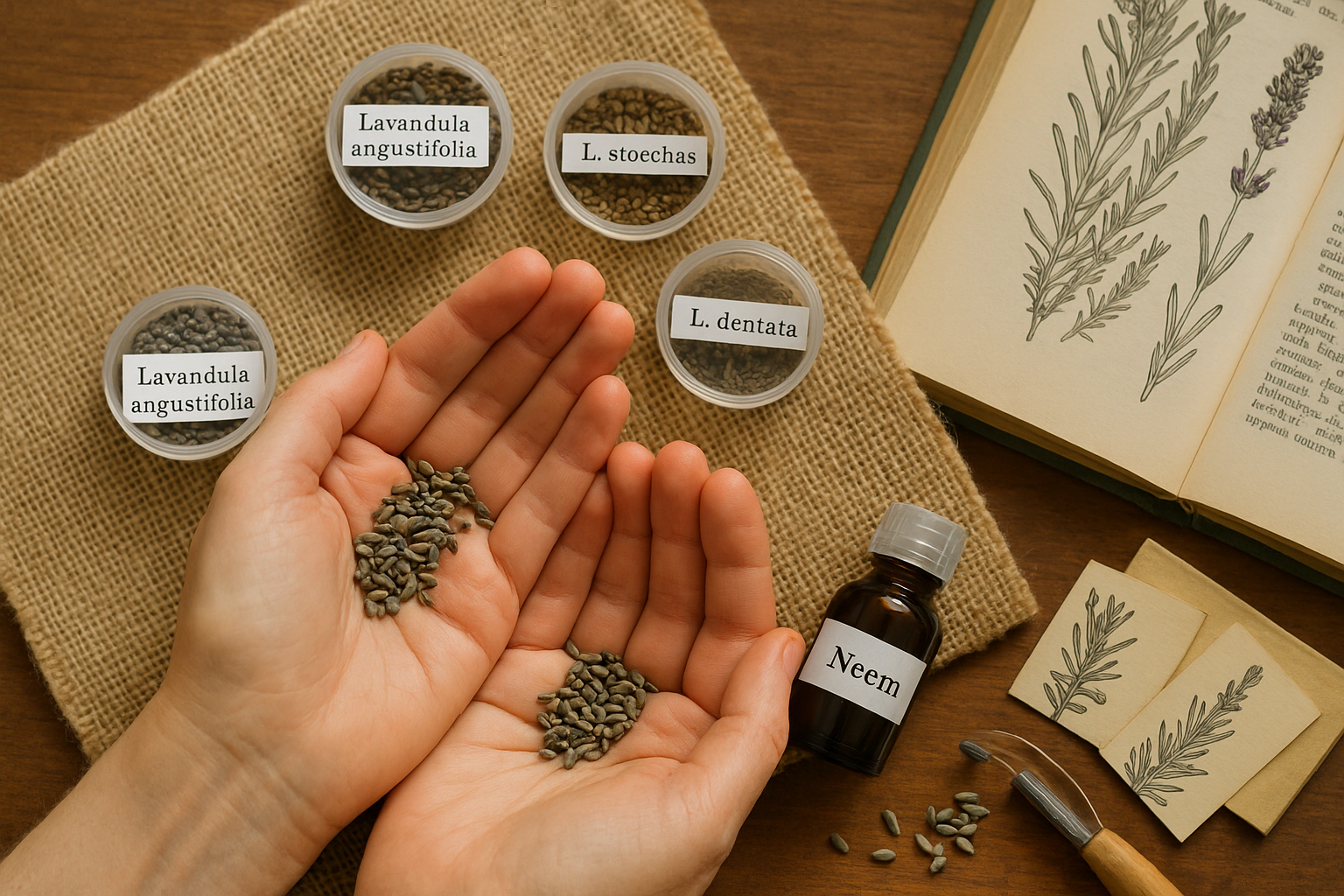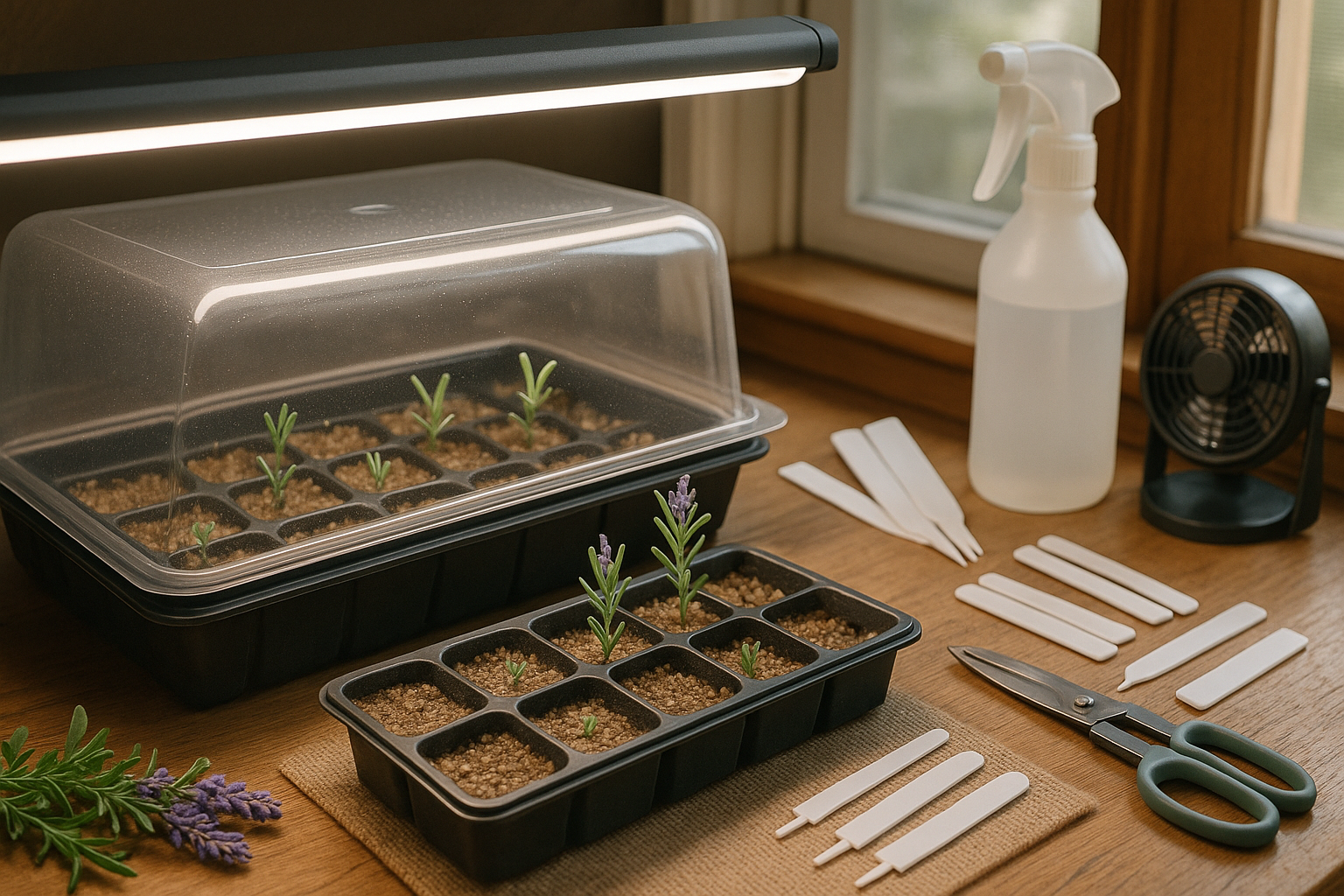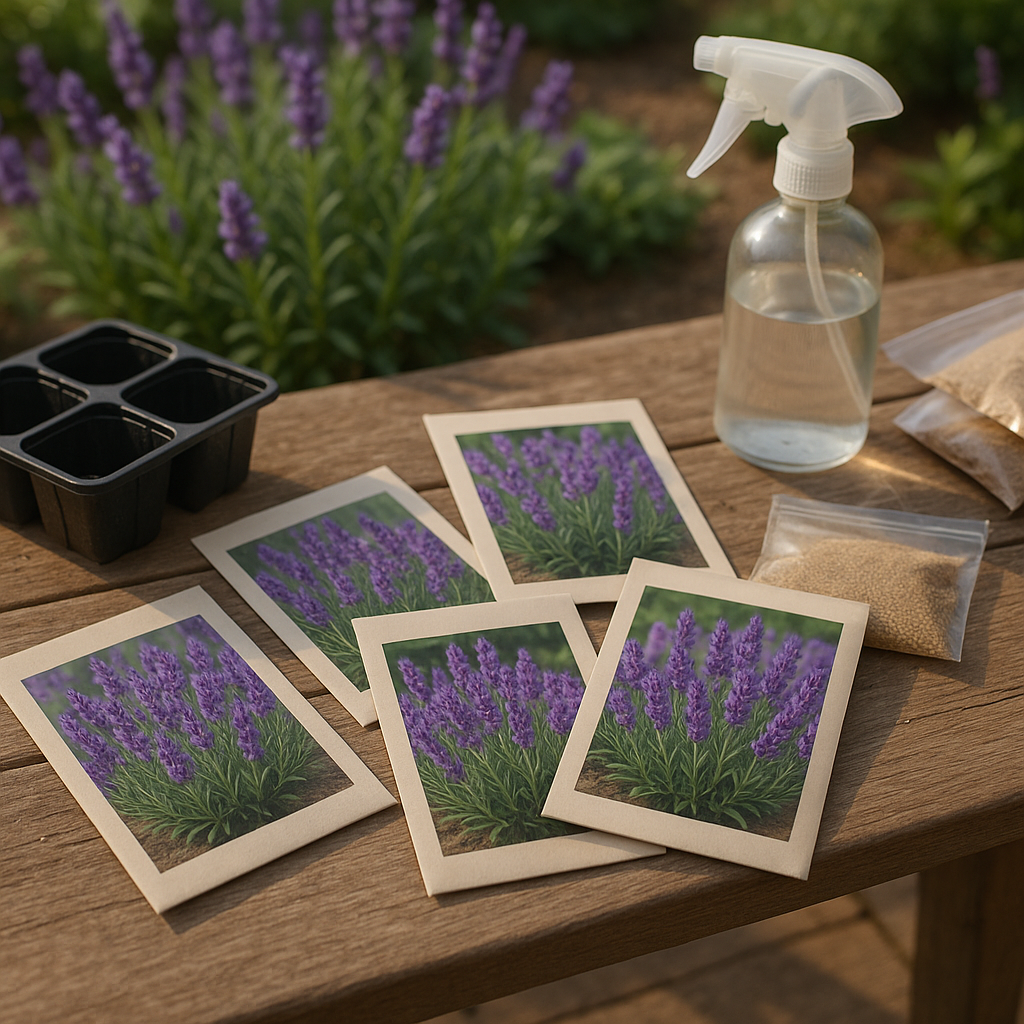Choosing the Right Lavender Seeds

When it comes to choosing the right lavender seeds, it’s important to know which varieties suit your garden and growing conditions. Popular options like English lavender (Lavandula angustifolia), Spanish lavender (L. stoechas), and French lavender (L. dentata) each offer unique benefits.
English lavender is a favorite for its classic fragrance and reliable hardiness, making it well-suited to cooler climates and great for culinary uses. Spanish and French lavenders thrive in warmer areas and are prized for their bold, ornamental flowers, although they are generally less cold-tolerant than English types.
As you browse for seeds, always check the seed packet for detailed information:
- Look for the Latin name to confirm the exact species.
- Check germination rates, which can vary widely—lavender seeds sometimes have lower germination rates, especially for more decorative or less common varieties. A rate around 50–70% is typical, so don’t be discouraged if not every seed sprouts.
- Pay attention to packet dates to ensure freshness, as older seeds may not perform as well.
For the best results, purchase seeds from established suppliers or specialty herb seed companies with positive reviews and clear sourcing information. This helps you avoid off-type plants or seeds that won’t grow well. Major online retailers and local garden centers are solid options, but always check vendor reputations and avoid deals that seem unusually cheap or vague about the source.
When possible, choose vendors who offer organic or untreated seeds, as these tend to have fewer chemical residues and are better for pollinators.
Lastly, be realistic about the challenges—lavender seeds can be slow to sprout even under ideal conditions. Hybrid or showy types like Spanish lavender often have lower success rates from seed than traditional English varieties. Be patient, start extra seeds to improve your odds, and don’t hesitate to try starter plants if seeds prove tricky. Proper selection and a little research up front will set your lavender patch up for blooming success!
When and Where to Start Lavender Seeds
Starting lavender seeds at the right time can make all the difference in growing healthy, vibrant plants. Generally, it’s best to sow seeds indoors 10 to 12 weeks before your last spring frost. This head start is essential in cooler climates, where direct sowing outdoors isn’t practical because lavender loves warmth and may struggle to germinate before summer arrives.
Indoor starting lets you control factors like temperature and light, giving seeds the boost they need for successful sprouting. If you’re in a mild winter region where frost is rare or short-lived, direct sowing outdoors in early spring might work, as long as the soil stays well above freezing and daytime temperatures remain cool yet stable.
For most gardeners, though, the safe bet is starting seeds inside. Choose a bright, south-facing windowsill or use grow lights to provide at least 8 hours of light each day—lavender seedlings need plenty of light to avoid becoming thin and leggy. Keep the room consistently warm, ideally between 65 and 70°F (18-21°C), and try to avoid dramatic temperature swings between day and night.
Humidity is another key factor; too much moisture can cause seeds to rot. Use a well-draining, sandy seed-starting mix and lightly mist the surface rather than soaking it. A clear humidity dome or plastic wrap can help retain moisture, but be sure to ventilate daily to prevent fungal growth.
Once your seedlings are established and all danger of frost has passed, gradually acclimate them to outdoor conditions by hardening them off over a week before planting in the garden. With a bit of planning and careful monitoring, you’ll grow strong, fragrant lavender plants ready to thrive in their summer home.
Preparing for Lavender Seed Germination
Starting lavender from seed can be incredibly rewarding, but it requires some careful preparation. Begin by gathering all your supplies: seed trays or small pots, well-draining seed starting mix (avoid regular garden soil), a spray bottle for misting, and clear covers or plastic wrap to maintain humidity.
If you’re growing indoors or lack bright sunlight, a simple grow light is invaluable for giving seedlings the best start.
Cold Stratification
One crucial step with lavender seeds is cold stratification—this helps overcome natural dormancy and boosts germination rates. To stratify, place seeds between moist paper towels or in a small resealable bag with slightly damp vermiculite or sand, then refrigerate them (not freeze) for 3-4 weeks before planting. This mimics the winter conditions the seeds need to “wake up.”
Soil Preparation
Meanwhile, prep your soil by mixing in a bit of sand or perlite for extra drainage—lavender hates wet feet, and soggy soil is a recipe for failure. Fill trays or pots with your prepared soil, gently firming it down, and water lightly so it’s moist but not saturated.
Sowing and Care
After stratification, sow seeds on the surface and barely cover them with a dusting of soil, since lavender needs some light to germinate. Mist daily to keep the top layer moist and place trays under your grow light or by a sunny window.
A clear cover can help hold in humidity, but be sure to vent it daily to avoid fungal problems. Label your trays so you don’t lose track of varieties or dates.
With a little patience and attention to these details, you’ll set yourself up for healthy, vigorous lavender seedlings ready to thrive in your garden.
Planting Lavender Seeds Indoors (Step-by-Step)

Starting lavender from seed indoors can be highly rewarding with a little extra care and patience. Begin by choosing a high-quality, well-draining seed starting mix—lavender dislikes soggy conditions, so avoid heavy soils.
Fill shallow trays or small pots with the mix, and gently press the seeds on top; lavender seeds require light to germinate, so barely cover them with a thin dusting of soil (no more than 1/8 inch). Lightly mist the surface with a spray bottle until evenly moist, but never soaking wet—too much water encourages fungal problems.
It’s best to use a humidity dome or clear plastic wrap to help retain moisture, but be sure to lift it daily for a few minutes to allow fresh air circulation. This step is important because good airflow prevents damping-off disease, a common killer of seedlings caused by excess humidity and stale air.
Place your tray in a warm, bright spot—ideally where temperatures stay between 65–70°F (18–21°C)—but avoid direct sunlight that could overheat or dry out the soil. Lavender seeds are notoriously slow to wake up, so patience is key; they typically germinate within 14–28 days, though some may take a little longer.
During this period, check daily to make sure the mix remains consistently damp but never waterlogged—if the top starts to dry, give a quick, gentle spritz, but if you see standing water, remove the cover until excess moisture evaporates.
Once sprouts appear, remove the cover entirely and move seedlings to a spot with good air movement, perhaps near a gentle fan, to help them grow sturdy and reduce the risk of fungus. Thin out weaker seedlings so remaining plants each have room to grow, as crowding can trap moisture and limit airflow.
As leaves develop, continue watering sparingly: let the surface dry slightly before adding more, always mindful not to overdo it. Watch for signs of mold or dullness, which can be countered by improving circulation further or watering less.
With steady attention and careful daily checks, your lavender will soon be ready for its next phase—offering you healthy plants to eventually move outdoors once all risk of frost has safely passed.
Caring for Lavender Seedlings and Transplanting
Caring for young lavender seedlings starts with ensuring they get plenty of bright, indirect sunlight—aim for at least 6–8 hours a day by placing them near a south-facing window or under full-spectrum grow lights. If you notice your seedlings getting leggy and stretching toward the light, it’s a sign they need more brightness. Move them closer to the light source and rotate trays regularly for even growth.
Keep the soil consistently moist but never soggy; lavender seedlings are sensitive to both overwatering and underwatering. A good routine is to let the top inch of soil dry out before watering again. Always use pots with drainage holes to prevent waterlogged roots, which can lead to mold. Thin the seedlings when they develop two sets of true leaves by snipping the weaker ones at soil level—this ensures stronger plants get more space, nutrients, and airflow, helping avoid fungal issues.
Transplanting Lavender Seedlings
When your lavender seedlings are about 2–3 inches tall with several true leaves, it’s time to prepare for transplanting, whether into larger pots or directly into your garden. Before moving them outdoors, introduce the plants gradually to outside conditions through a process called hardening off. Start by placing seedlings outside for just an hour or two in a sheltered, partly shady spot, then increase their outdoor time and direct sunlight exposure over a week to ten days. This toughens them up so they won’t be shocked by sun, wind, or temperature changes.
For outdoor planting, choose a well-draining spot with full sun, and space each plant about 12–18 inches apart to promote good airflow and healthy roots.
Troubleshooting Common Issues
- If you notice fuzzy mold on the soil or stems, improve air circulation and avoid watering from above. Remove any affected material and, if needed, treat with a natural fungicide like diluted chamomile tea.
- For leggy growth, increase light and gently brush your hand over the seedlings once a day—this simulates outdoor breezes and can help strengthen the stems.
These simple steps lay the groundwork for robust, fragrant lavender that will thrive as it grows.
Direct Sowing and Outdoor Care
Direct sowing lavender seeds outdoors is a rewarding approach, especially if you live in a mild climate with minimal frost. Aim to plant when night temperatures consistently stay above 50°F (10°C)—typically in late spring after the danger of frost has passed.
Start by choosing a spot that receives full sun for at least six to eight hours a day, as lavender thrives in bright, warm locations. Good drainage is key: lavender hates “wet feet,” so avoid low-lying fields and consider a raised bed if your soil tends to hold water. Sandy or gritty soil is ideal, but if yours is heavy clay, mix in plenty of sand, fine gravel, or compost to improve texture and drainage.
To sow, gently rake the soil surface and scatter seeds evenly; press them in lightly with your hand or a board—they need light to germinate, so don’t cover them deeply. Keep the area moist but never soggy as seeds sprout over two to four weeks. Mark the spot to avoid disturbing tender seedlings while gardening.
Once seedlings appear, thin them to about 12–18 inches apart, ensuring each plant has ample space for airflow and sunlight, which helps prevent fungal diseases.
For maintenance, water only when the soil is dry an inch below the surface; overwatering is the most common mistake. Mulch with light-colored gravel to reflect sunlight and discourage weeds, but avoid organic mulches that trap excess moisture.
As young lavender plants establish, monitor for aphids or fungal spots—remove affected leaves promptly. With these habits, you’ll support strong root growth, and by the second season, your plants should be robust, beautifully scented, and even ready for light harvests of their fragrant blooms.
Frequently Asked Questions on Growing Lavender from Seed
Growing lavender from seed can be a rewarding but sometimes tricky process, especially for beginners. One common problem is poor germination: lavender seeds are slow to sprout and need light to aid germination, so never bury them deeply—simply press them onto the soil surface and keep the tray moist but not soggy.
Cool temperatures, around 65°F (18°C), and patience are essential, as seeds can take two to four weeks to germinate, sometimes longer. If your seeds aren’t sprouting, check for old or poor-quality seeds and make sure the seed tray isn’t too wet or cold.
Once your seedlings are established, they need about one to two years to reach flowering size, although a few early blooms may appear sooner if growing conditions are excellent.
Watch out for common pests on young plants, like aphids and fungal gnats, which are attracted to overly damp soil—good airflow and avoiding overwatering help prevent infestations.
For best results, start seeds indoors in early spring and transplant outside after the last frost.
Bonus Tip
Use a free-draining soil mix and place seedlings in a sunny location, as lavender loves sunlight and well-aerated soil. Starting with proper care sets your lavender up for long-lasting success in your garden or pots.
